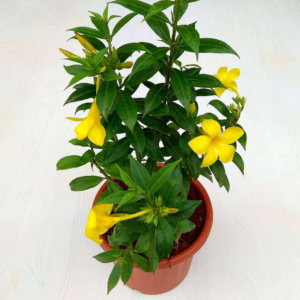Description
Jasmine Virajaji Bellflower Plant – A Botanical Marvel of Fragrance and Elegance
The Jasmine Virajaji Bellflower is an exquisite and enigmatic plant species that captivates horticulturists and nature lovers alike with its mesmerizing blend of aroma, aesthetics, and resilience. Blending the floral characteristics of the beloved jasmine (Jasminum spp.) with the whimsical architecture of the bellflower (Campanula spp.), and marked with the regional identity of “Virajaji”—a name resonant with tradition and culture—this plant stands as a unique marvel in the world of ornamental and therapeutic flora.
Origins and Nomenclature
The name Jasmine Virajaji Bellflower is as poetic as the plant itself. “Jasmine” conjures images of delicate white blooms and enchanting fragrance, symbolizing purity and grace in many cultures. “Bellflower” refers to the bell-shaped corolla of the Campanula genus, known for its diverse array of colors and woodland charm. The term “Virajaji” is believed to stem from regional dialects in South or Southeast Asia, possibly referring to a traditional hybrid or a locally cultivated variety of jasmine infused with unique traits.
Although not officially recognized in standard botanical texts, the Jasmine Virajaji Bellflower is often discussed among horticultural circles as a hybrid or naturally occurring cross with regional roots, possibly arising from interspecific breeding or spontaneous genetic mutation in garden cultivars.
Botanical Description
The Jasmine Virajaji Bellflower is a medium-sized perennial plant, typically reaching heights of 1.2 to 1.8 meters when mature. Its structure is semi-woody at the base with vine-like extensions, allowing it to climb trellises, archways, or grow in a bushy mound when left untrained. The leaves are lanceolate to ovate, with smooth edges and a glossy green surface, often exuding a faint sweet aroma when crushed.
The plant’s most distinguishing feature is its flower—a unique fusion between the flared, trumpet-like petals of jasmine and the nodding, bell-shaped blooms of the Campanula. Flowers range in color from creamy white to pale lavender, with some cultivars displaying a gradient of hues in the same cluster. Each flower measures around 3–5 centimeters across and emits a soft yet intoxicating fragrance, strongest at dusk and early morning.
Flowering occurs prolifically in late spring through early autumn, though in tropical climates, intermittent blooming may occur year-round. The inflorescences appear in loose panicles or cymes, each branch supporting multiple drooping bell-shaped blossoms that attract pollinators such as bees, butterflies, and hummingbirds.
Ecological and Cultural Significance
Ecologically, the Jasmine Virajaji Bellflower contributes to biodiversity in garden ecosystems, providing nectar and habitat for various beneficial insects. Its long blooming period and attractive flowers make it a favorite in pollinator gardens and eco-conscious landscaping.
Culturally, the plant is often associated with spiritual ceremonies and traditional healing. In folklore, it is believed that the Virajaji variety of jasmine carries calming and purifying properties, both for the mind and the environment. The bell-shaped blooms are said to symbolize divine connection, reminiscent of temple bells that ring with sacred vibrations.
In some regions, garlands made from the blossoms are offered in temples or worn during festive occasions, representing peace, devotion, and prosperity.
Cultivation and Care
Despite its exotic appearance, the Jasmine Virajaji Bellflower is a relatively hardy plant that thrives in temperate to tropical climates. It prefers well-drained soil, rich in organic matter, and benefits from regular watering, especially during dry spells. However, overwatering or poor drainage can lead to root rot, making it essential to plant in raised beds or containers with good aeration.
The plant thrives best in full sun to partial shade. In overly shaded conditions, it may exhibit leggy growth and reduced flowering. To encourage bushier growth and more blooms, gardeners are advised to perform regular pruning and deadheading of spent flowers.
Propagation is typically achieved through semi-hardwood cuttings taken during the growing season. These cuttings root readily in moist, sterile mediums and can be transplanted after establishing a robust root system. Though seeds are sometimes available, germination can be slow and erratic, making vegetative propagation the preferred method.
Pests and diseases are minimal but can include aphids, spider mites, and powdery mildew under high humidity. Integrated pest management techniques such as neem oil or insecticidal soap help maintain plant health without the use of harsh chemicals.
Landscape and Design Use
Gardeners and landscape designers prize the Jasmine Virajaji Bellflower for its versatility and ornamental appeal. It can be used in a variety of settings:
- Climbers on trellises and pergolas – creating fragrant garden arches.
- Containers and hanging baskets – cascading blooms for patios and balconies.
- Mixed borders and hedges – paired with roses, lavender, or salvia for texture and color.
- Spiritual gardens – as a centerpiece in meditative or sacred spaces.
The combination of graceful form and intoxicating fragrance also makes this plant a popular choice for courtyard gardens and wedding décor, where it lends a romantic and serene atmosphere.
Medicinal and Aromatherapeutic Uses
While not extensively studied in modern pharmacology, traditional medicine systems often use jasmine flowers for their sedative, antispasmodic, and mood-enhancing properties. Essential oils derived from the plant’s flowers are used in aromatherapy to reduce anxiety, enhance focus, and promote restful sleep.
The Jasmine Virajaji Bellflower, particularly if it carries the therapeutic essence of both jasmine and bellflower lineages, is thought to be especially effective in calming the nervous system and balancing emotional states. Some herbalists infuse the blossoms into teas or tinctures, though caution is advised due to the hybrid nature of the plant, and consultation with professionals is always recommended.
Symbolism and Mythology
Symbolically, the Jasmine Virajaji Bellflower represents a union of opposites—the grounded beauty of the jasmine and the celestial uplift of the bellflower. In regional myths, it is said that this plant was a gift from the moon goddess to a heartbroken poet, its scent carrying messages of lost love through the night air.
Its blooms are seen as emblems of devotion, transformation, and subtle power—qualities that mirror the plant’s quiet but profound impact on the senses and the soul.
Conclusion
The Jasmine Virajaji Bellflower is more than a mere ornamental plant; it is a living sculpture of beauty and balance. Whether climbing a garden trellis, wafting its sweet scent through a quiet courtyard, or being gathered into ceremonial garlands, this remarkable botanical blend continues to enchant and inspire. A bridge between worlds—of tradition and innovation, fragrance and form—the Jasmine Virajaji Bellflower is a testament to nature’s endless artistry and humanity’s enduring admiration for the floral realm.





 Anthurium (Pink) - Plant
Anthurium (Pink) - Plant 

Reviews
There are no reviews yet.